A Compact Crossed Inverted-V Antenna with a Common Reflector for Polarization Diversity in the IoT
Abstract
1. Introduction
2. Antenna Design
3. Measurements
4. Conclusions
Author Contributions
Funding
Acknowledgments
Conflicts of Interest
References
- Panwar, N.; Sharma, S.; Singh, A.K. A survey on 5G: The next generation of mobile communication. Phys. Commun. 2016, 18, 64–84. [Google Scholar] [CrossRef]
- Agiwal, M.; Roy, A.; Saxena, N. Next generation 5G wireless networks: A comprehensive survey. IEEE Commun. Surv. Tutor. 2016, 18, 1617–1655. [Google Scholar] [CrossRef]
- Andrews, J.G.; Choi, W.; Hanly, S.V.; Soong, C.K.; Zhang, J.C. What will 5G be? IEEE J. Sel. Areas Commun. 2014, 32, 1065–1082. [Google Scholar] [CrossRef]
- Wiklundh, K.; Stenumgaard, P. EMC challenges for the internet of things. In Proceedings of the IEEE EMC 2017, Angers, France, 4–7 September 2017. [Google Scholar]
- Xu, L.D.; He, W.; Li, S. Internet of things in industries: A survey. IEEE Trans. Ind. Inform. 2014, 10, 2233–2243. [Google Scholar] [CrossRef]
- Li, S.; Xu, L.D.; Zhao, S. 5G internet of things: A survey. J. Ind. Inf. 2018, 10, 1–9. [Google Scholar] [CrossRef]
- Cheng, J.; Chen, W.; Tao, F.; Lin, C. Industrial IoT in 5G environment towards smart manufacturing. J. Ind. Inf. 2018, 10, 10–19. [Google Scholar] [CrossRef]
- Al-Yasir, Y.I.A.; Abdullah, A.S.; Parchin, N.O.; Abd-Alhameed, R.A.; Noras, J.M. A new polarization-reconfigurable antenna for 5G applications. Electronics 2018, 7, 293. [Google Scholar] [CrossRef]
- Tang, H.; Zong, X.; Nie, Z. Broadband dual-polarized base station for fifth-generation (5G) applications. Sensors 2018, 18, 2701. [Google Scholar] [CrossRef]
- Qin, P.; Guo, Y.J.; Liang, C. Effect of antenna polarization diversity on MIMO system capacity. IEEE Antennas Wirel. Propag. Lett. 2010, 9, 1092–1095. [Google Scholar] [CrossRef]
- Sung, Y.J. Reconfigurable patch antenna for polarization diversity. IEEE Trans. Antennas Propag. 2008, 56, 3053–3054. [Google Scholar] [CrossRef]
- Wu, Y.; Wu, C.; Lai, D.; Chen, F. A reconfigurable quadri-polarization diversity aperture-coupled patch antenna. IEEE Trans. Antennas Propag. 2007, 55, 1009–1012. [Google Scholar] [CrossRef]
- Row, J.; Wei, Y. Wideband reconfigurable crossed-dipole antenna with quad-polarization diversity. IEEE Trans. Antennas Propag. 2018, 66, 2090–2094. [Google Scholar] [CrossRef]
- Su, D.; Qian, J.J.; Yang, H.; Fu, D. A novel broadband polarization diversity antenna using a cross-pair of folded dipoles. IEEE Antennas Wirel. Propag. Lett. 2005, 4, 3–5. [Google Scholar]
- Khaleghi, A.; Kamyab, M. Reconfigurable single port antenna with circular polarization diversity. IEEE Antennas Wirel. Propag. Lett. 2009, 57, 555–559. [Google Scholar] [CrossRef]
- Yang, W.; Pan, Y.; Zheng, S.; Hu, P. A low-profile wideband circularly polarized crossed-dipole antenna. IEEE Antennas Wirel. Propag. Lett. 2017, 16, 2126–2129. [Google Scholar] [CrossRef]
- Feng, G.; Chen, L.; Xue, X.; Shi, X. Broadband circularly polarized crossed-dipole antenna with a single asymmetrical cross-loop. IEEE Antennas Wirel. Propag. Lett. 2017, 16, 3184–3187. [Google Scholar] [CrossRef]
- Nakamura, T.; Honho, T. Single-fed crossed V-dipoles with four masts for circular polarization. Electron. Commun. 2002, 85, 44–51. [Google Scholar] [CrossRef]
- Feng, C.; Zhang, F.; Sun, F. A broadband crossed dipole antenna with wide axial ratio beamwidth for satellite communications. Prog. Electromagn. Res. Lett. 2018, 77, 59–64. [Google Scholar] [CrossRef]
- Parchin, N.O.; Basherlou, H.J.; Al-Yasir, Y.I.A.; Abd-Alhameed, R.A.; Abdulkhaleq, A.M.; Noras, J.M. Recent developments of reconfigurable antennas for current and future wireless communication systems. Electronics 2019, 8, 128. [Google Scholar] [CrossRef]
- Hu, W.; Wen, G.; Inserra, D.; Huang, Y.; Li, J.; Chen, Z. A circularly polarized antenna array with gain enhancement for long-range UHF RFID systems. Electronics 2019, 8, 400. [Google Scholar] [CrossRef]
- Iqbal, A.; Smida, A.; Mallat, N.K.; Ghayoula, R.; Elfergani, I.; Rodriguez, J.; Kim, S. Frequency and pattern reconfigurable antenna for emerging wireless communication systems. Electronics 2019, 8, 407. [Google Scholar] [CrossRef]
- Tsai, J.; Row, J. Reconfigurable square-ring microstrip antenna. IEEE Trans. Antennas Propag. 2013, 61, 2857–2860. [Google Scholar] [CrossRef]
- Ji, L.; Qin, P.; Guo, Y.J.; Ding, C.; Fu, G.; Gong, S. A wideband polarization reconfigurable antenna with partially reflective surface. IEEE Trans. Antennas Propag. 2016, 64, 4534–4538. [Google Scholar] [CrossRef]
- Fan, Y.; Li, R.; Cui, Y. Development of polarisation reconfigurable omnidirectional antennas using crossed dipoles. IET Microw. Antennas Propag. 2019, 13, 485–491. [Google Scholar] [CrossRef]
- Feng, B.; Luo, T.; Zeng, Q.; Chung, K. Frequency reconfigurable antenna with triple linear polarization and wide H-plane characteristic for future smart communications. IET Microw. Antennas Propag. 2018, 12, 2276–2284. [Google Scholar] [CrossRef]
- Bhattacharjee, A.; Dwari, S.; Mandal, M.K. Polarization-reconfigurable compact monopole antenna with wide effective bandwidth. IEEE Trans. Antennas Propag. 2019, 18, 1041–1047. [Google Scholar] [CrossRef]
- Chu, L.J. Physical limitations of omni-directional antennas. J. Appl. Phys. 1948, 19, 1163–1175. [Google Scholar] [CrossRef]
- Geyi, W. Optimization of the ratio of gain to Q. IEEE Trans. Antennas Propag. 2013, 61, 1916–1922. [Google Scholar] [CrossRef]
- Pigeon, M.; Clemente, A.; Delaveaud, C.; Rudant, L. Analysis of harrington limit for electrically small antenna directivity. In Proceedings of the 8th European Conference on Antennas and Propagation (EuCAP 2014), The Hague, The Netherlands, 6–11 April 2014. [Google Scholar]
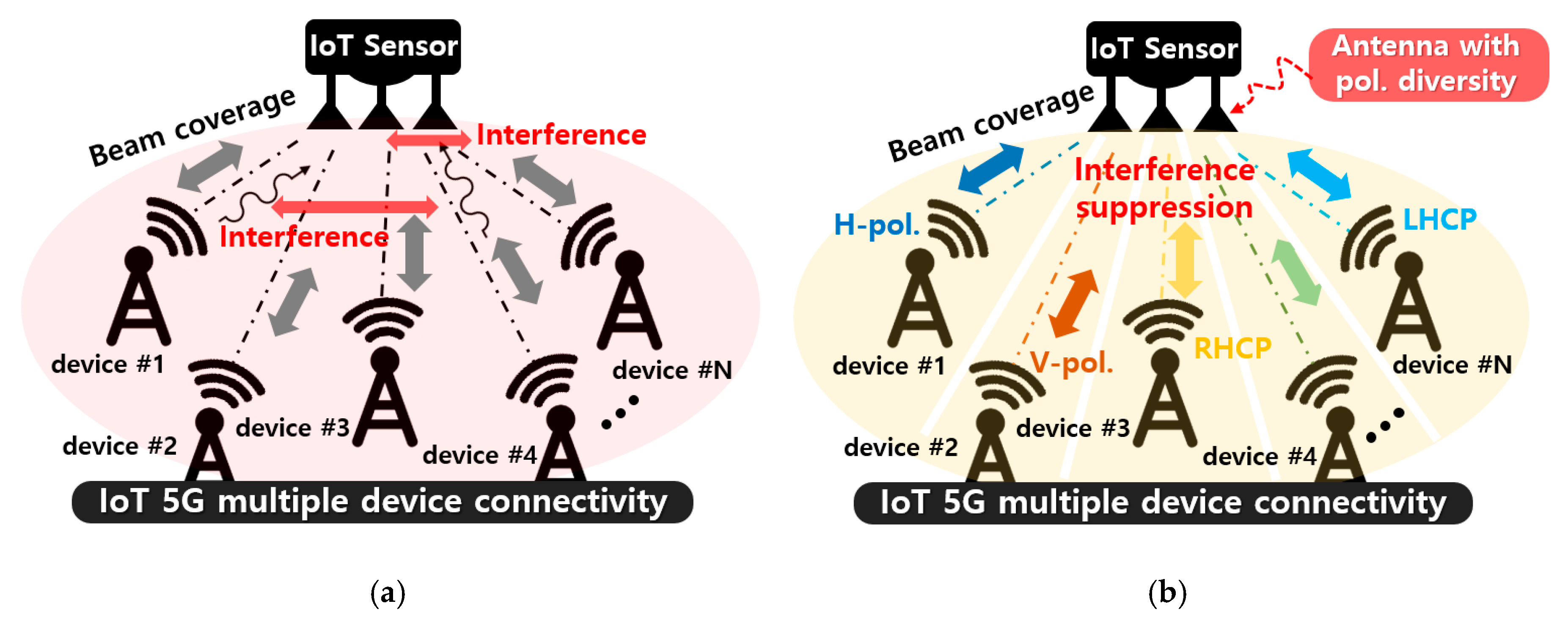
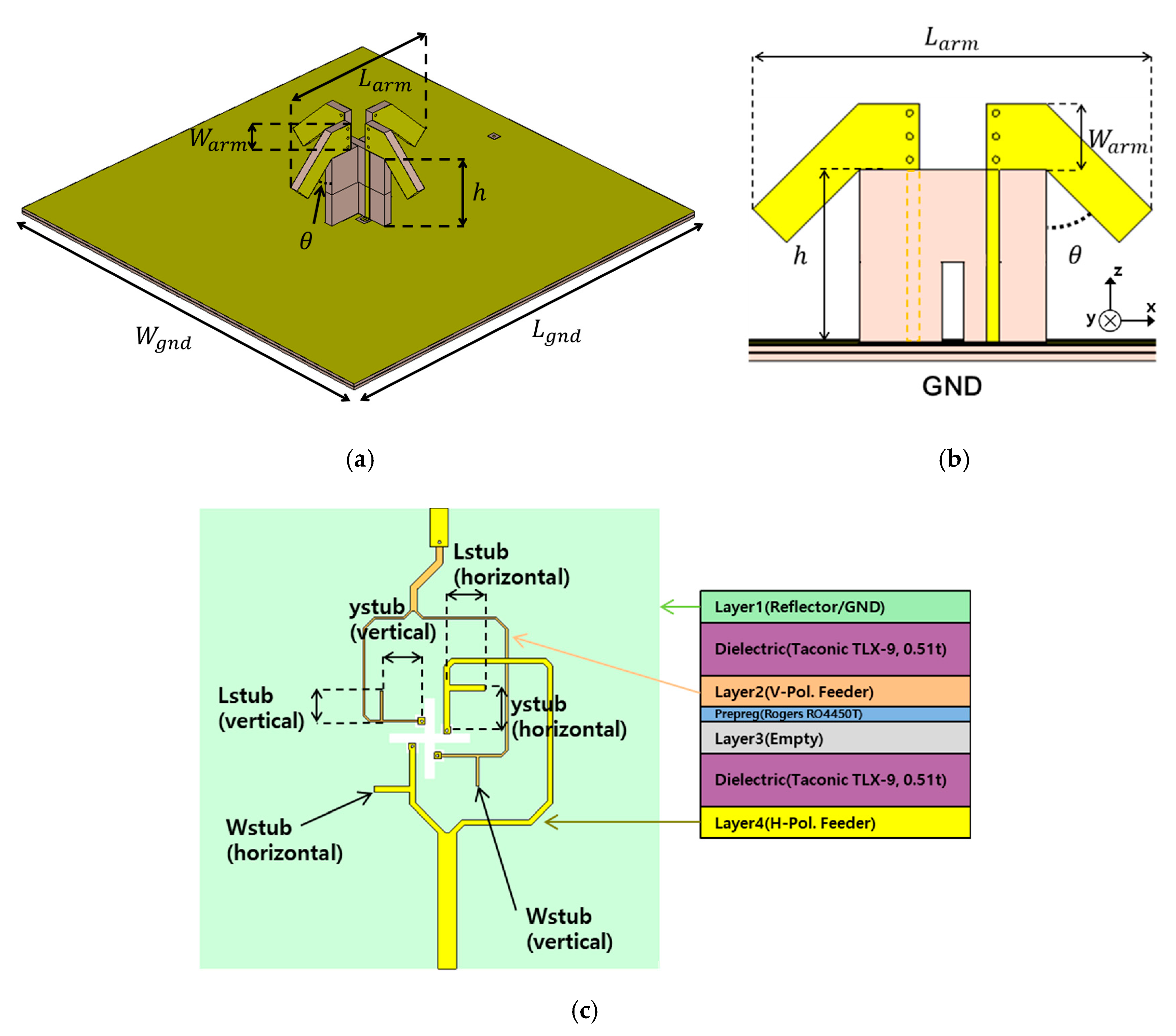
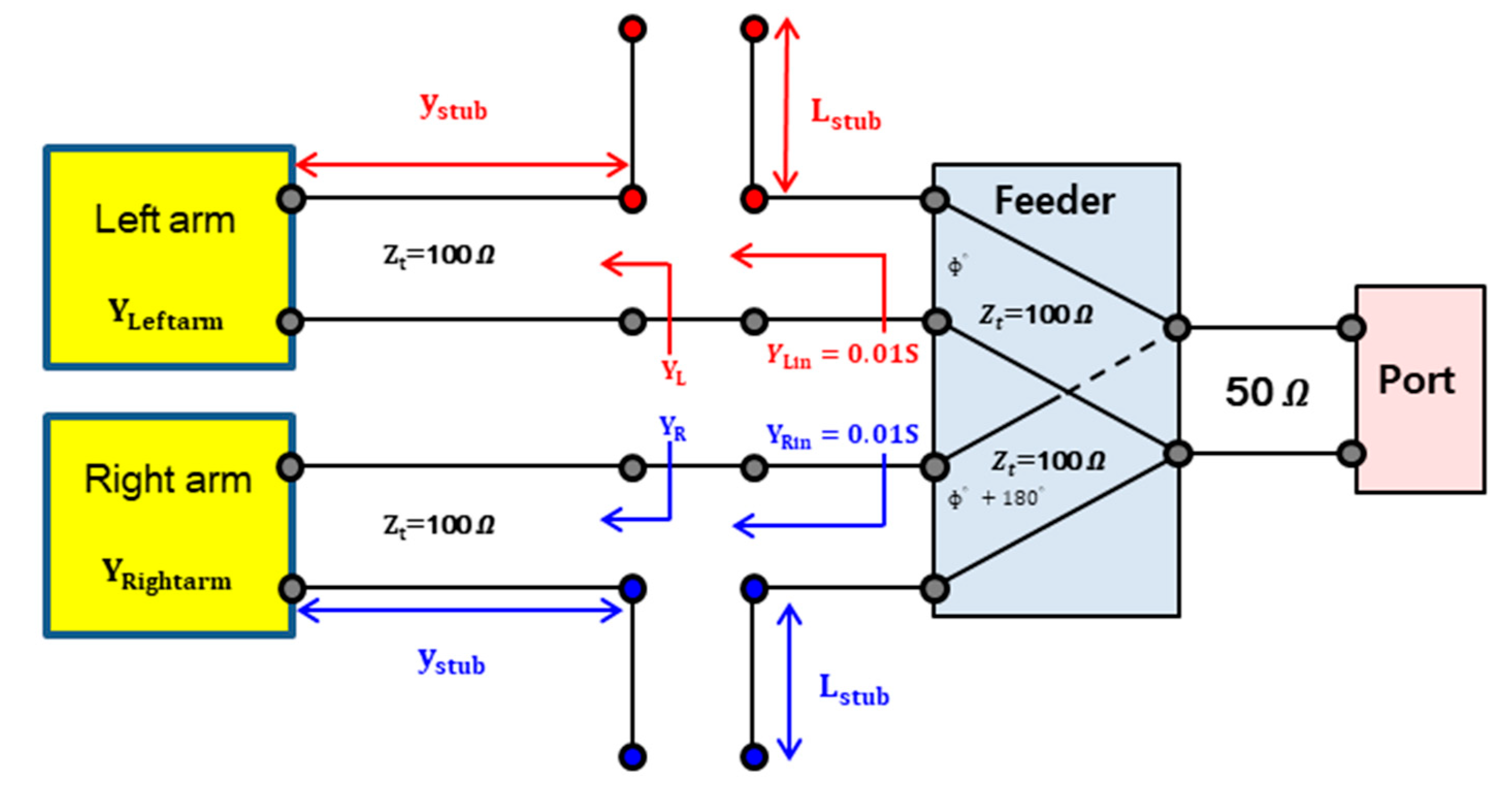
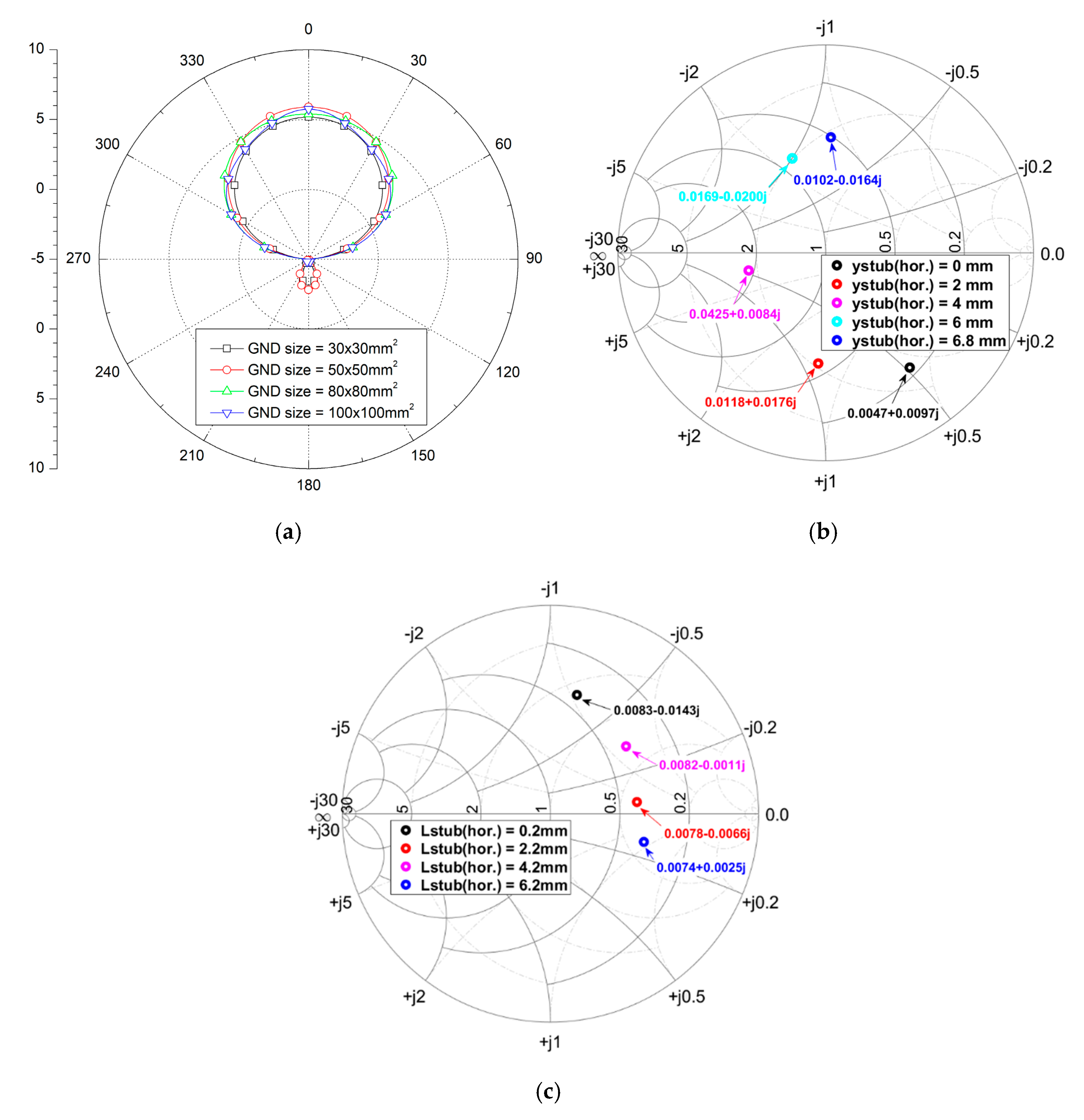
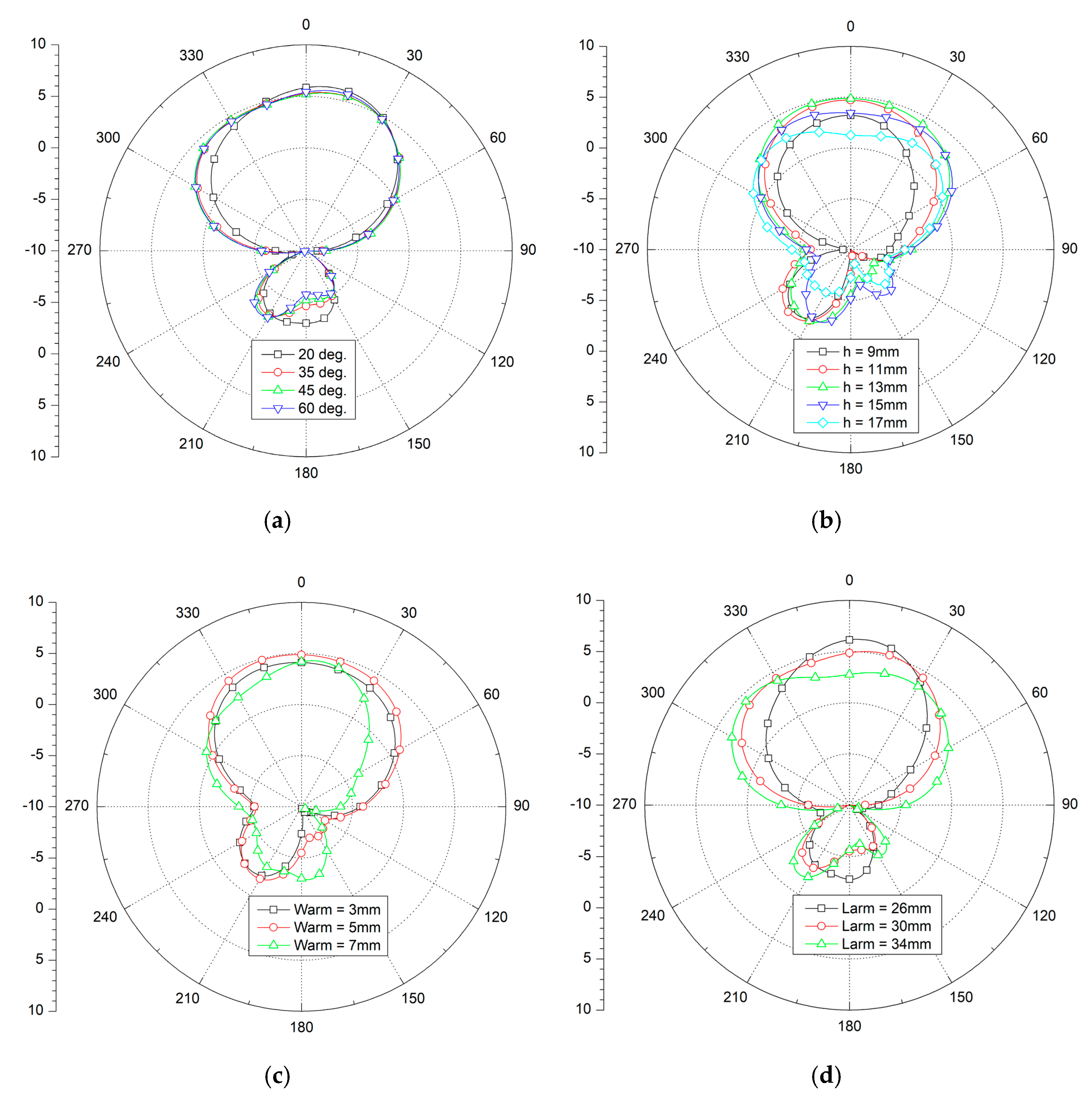
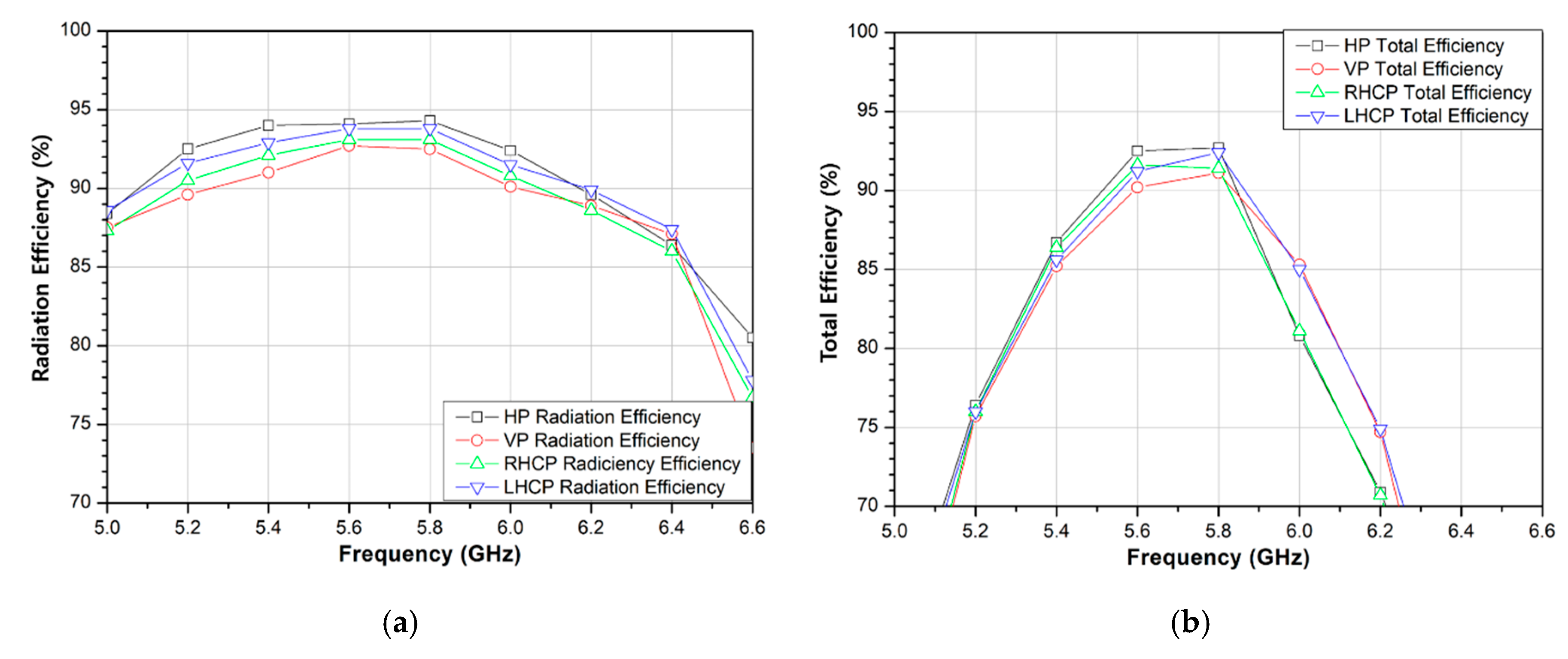
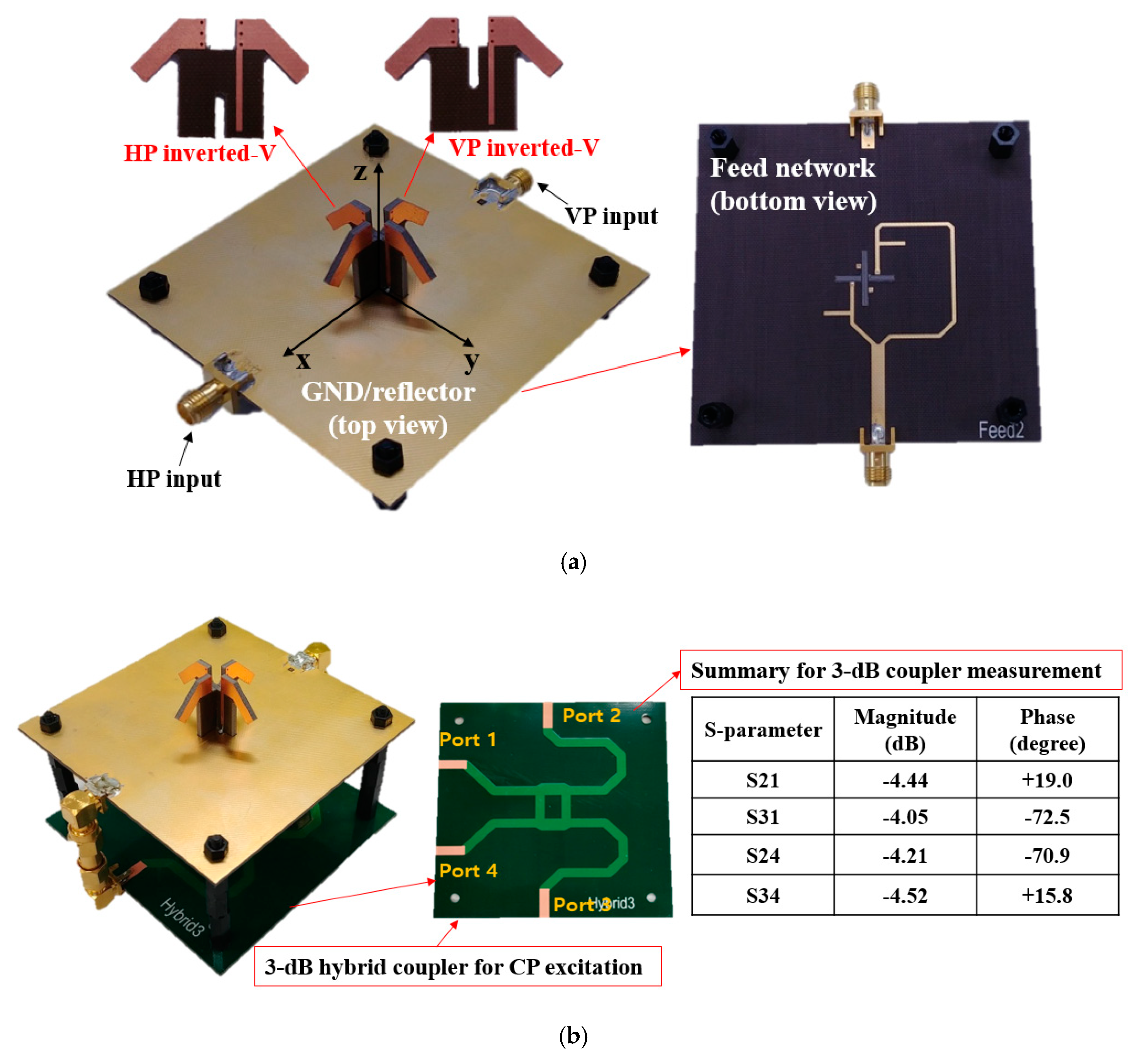
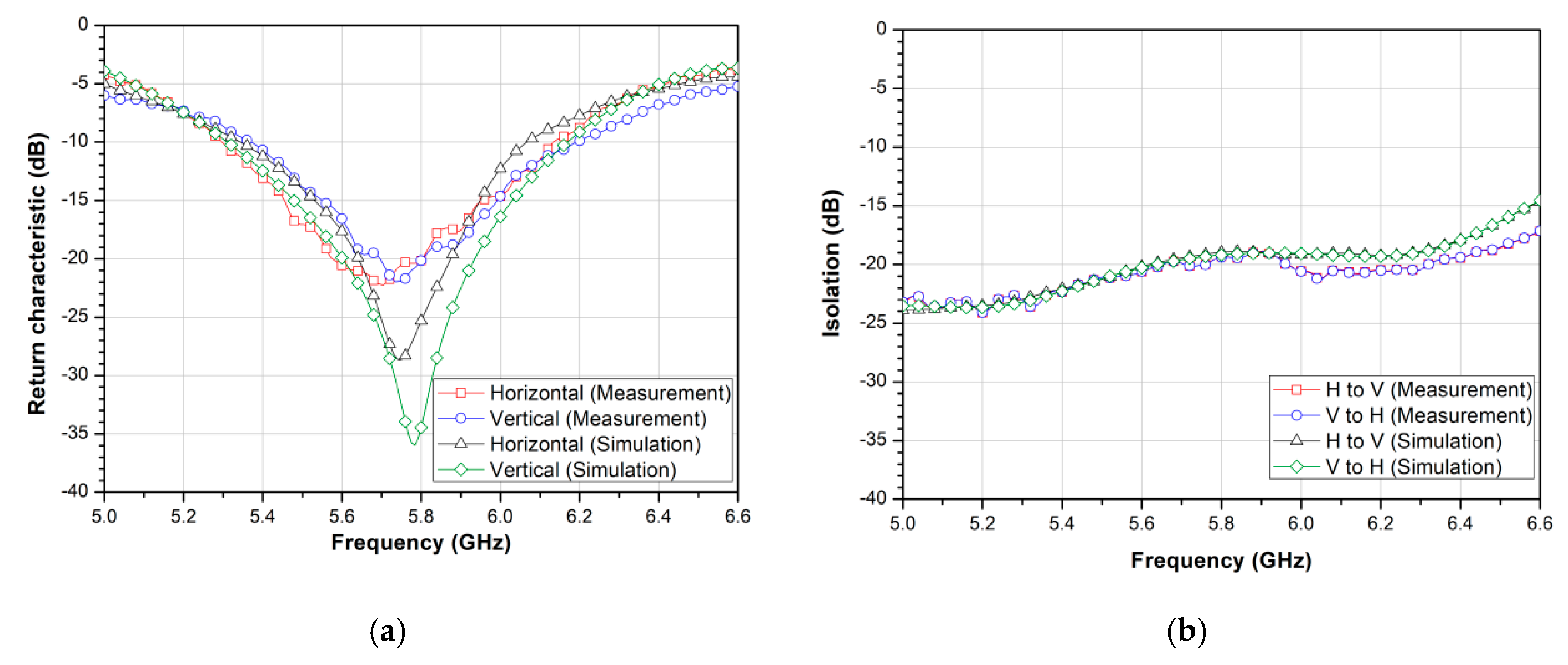
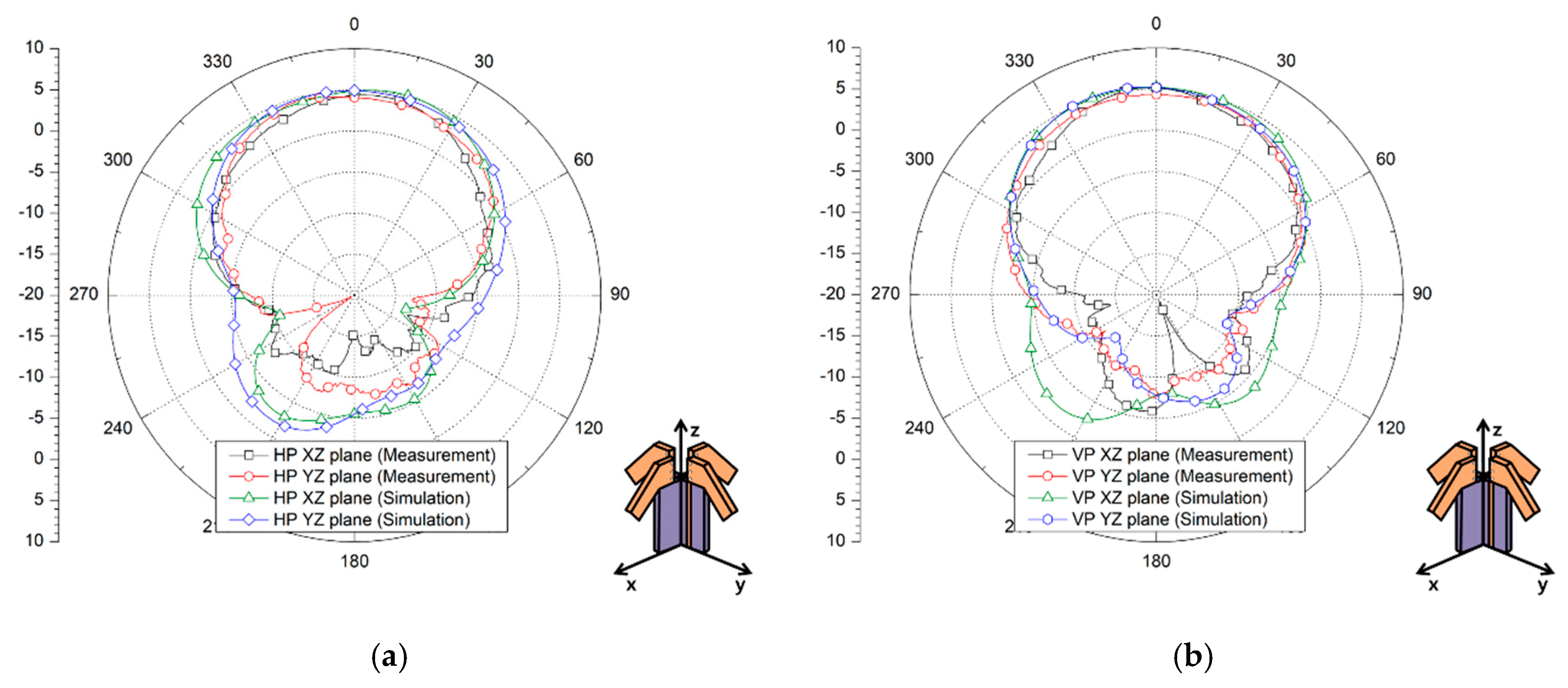
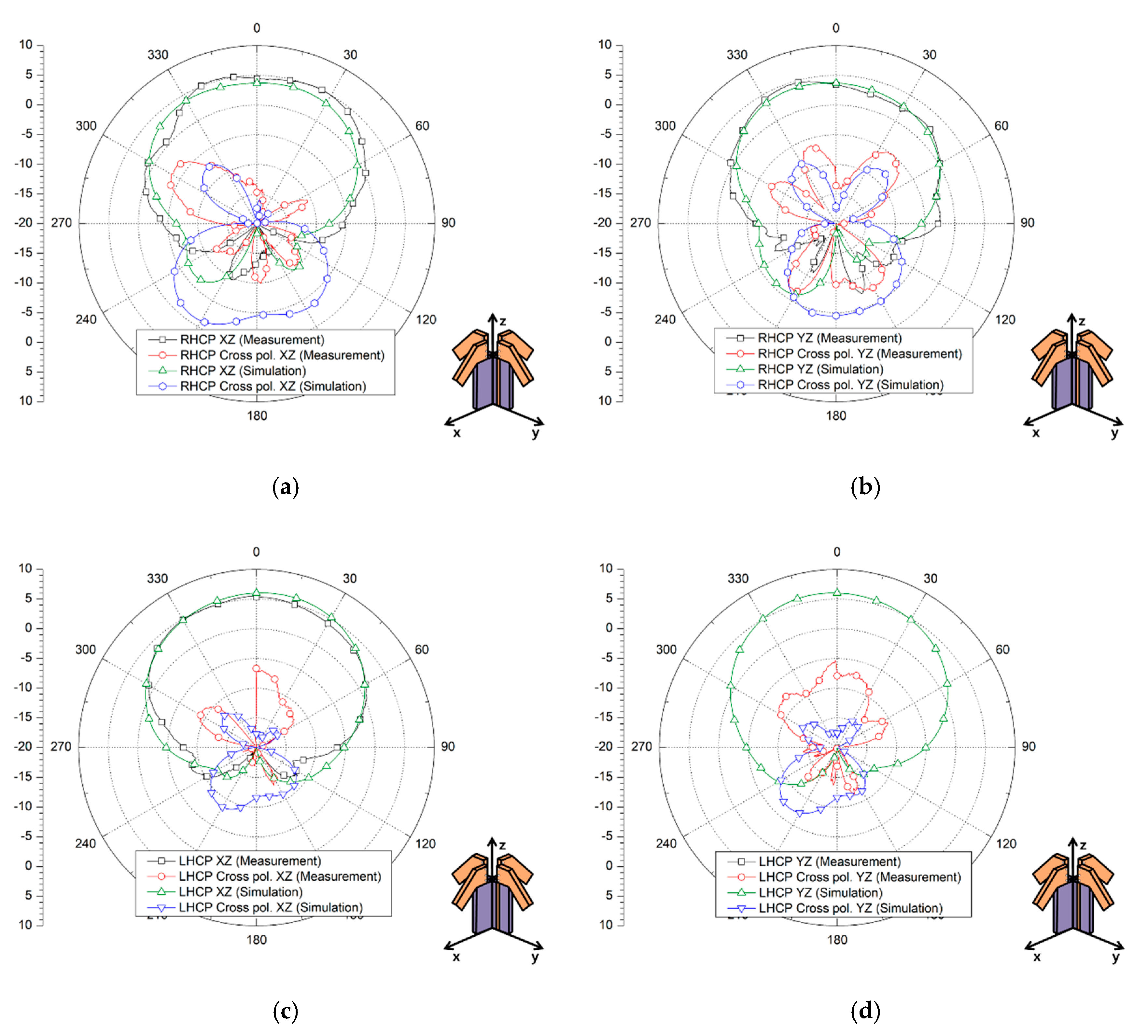
| Inverted-V | Larm | Warm | h | θ | Lgnd | Wgnd | Lstub | ystub | Wstub * |
|---|---|---|---|---|---|---|---|---|---|
| Horizontal | 30 mm | 5 mm | 13 mm | 45° | 80 mm | 80 mm | 6.2 mm | 6.8 mm | 1 mm |
| Vertical | 30 mm | 5 mm | 13 mm | 45° | 80 mm | 80 mm | 5.1 mm | 6.4 mm | 0.5 mm |
| HP (XZ/YZ) | VP (XZ/YZ) | RHCP(XZ/YZ) | LHCP (XZ/YZ) | |
|---|---|---|---|---|
| Gain | 4.43 dBi/4.61 dBi | 4.40 dBi/5.20 dBi | 4.67 dBic/5.25 dBic | 5.51 dBic/4.41 dBic |
| HPBW | 82°/94° | 78°/106° | 91°/101° | 106°/110° |
| Gain/Q | 0.57/0.60 | 0.57/0.60 | 0.61/0.68 | 0.71/0.57 |
| Ref. | Center Freq. (GHz) | Volume (λo3) * | ka | Peak Gain (dBic) | HPBW (°) | IBW (%) | Polarizations |
|---|---|---|---|---|---|---|---|
| [16] | 5.5 | 1.28 × 1.28 × 0.13 | 4.03 | 10.4 | - | 66.9 | RHCP |
| [17] | 5.5 | 1.57 × 1.57 × 0.31 | 4.96 | 10.62 | - | 67.5 | RHCP |
| [19] | 2.8 | 0.51 × 0.51 × 0.35 | 1.61 | 4.8 | 187 | 70.6 | RHCP |
| This work | 5.8 | 0.58 × 0.58 × 0.25 | 1.82 | 5.51 | 110 | 13.0 | HP, VP, RHCP, LHCP |
© 2019 by the authors. Licensee MDPI, Basel, Switzerland. This article is an open access article distributed under the terms and conditions of the Creative Commons Attribution (CC BY) license (http://creativecommons.org/licenses/by/4.0/).
Share and Cite
Park, K.; Joung, J.; Lim, S.; Lee, H.L. A Compact Crossed Inverted-V Antenna with a Common Reflector for Polarization Diversity in the IoT. Electronics 2019, 8, 637. https://doi.org/10.3390/electronics8060637
Park K, Joung J, Lim S, Lee HL. A Compact Crossed Inverted-V Antenna with a Common Reflector for Polarization Diversity in the IoT. Electronics. 2019; 8(6):637. https://doi.org/10.3390/electronics8060637
Chicago/Turabian StylePark, Kibeom, Jingon Joung, Sungjoon Lim, and Han Lim Lee. 2019. "A Compact Crossed Inverted-V Antenna with a Common Reflector for Polarization Diversity in the IoT" Electronics 8, no. 6: 637. https://doi.org/10.3390/electronics8060637
APA StylePark, K., Joung, J., Lim, S., & Lee, H. L. (2019). A Compact Crossed Inverted-V Antenna with a Common Reflector for Polarization Diversity in the IoT. Electronics, 8(6), 637. https://doi.org/10.3390/electronics8060637








